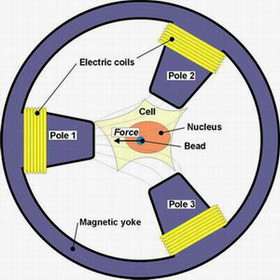Scheme of the micromechanical experiments. Magnetic poles (6 µm wide, 20 µm separation) generate a force on a paramagnetic bead positioned in the nucleus of a HeLa cell. Electric coils allow the control of amplitude and direction of the force. Magnetic yoke and electric coils are not to scale. Credit: University of Twente
By injecting tiny magnetic beads into a living cell and manipulating them with a magnetic ‘tweezer’, scientists of the University of Twente, The Netherlands, succeed in getting to know more about the mechanics of the cell nucleus.
The way DNA is ‘translated’ into the specific functions of the cell strongly depends on the mechanics, so this information is of great value. Scientists Anthony de Vries, Hans Kanger and Vinod Subramaniam of the Biophysical Engineering Group present their results in Nano Letters.
The spatial organization in a living cell tells a lot about the way the cell works and the molecular processes within. It is clearly indicated that the mechanical properties of DNA and chromatin –the complex of DNA and proteins- play a major role in the activity of thousands of genes. Gene expression, in which DNA expresses itself in functional proteins, seems to depend highly on these mechanical properties. Until now, only individual chromosomes have been investigated: the new method allows scientists to monitor the mechanical properties of chromatin within the cell and investigate the internal structure of the cell nucleus.
Three magnets
The UT-scientists therefore inject a bead into the cell nucleus using a micro pipette. The bead is about 1 micron in diameter. The cell is placed in the centre of three tiny magnets (micron dimensions). Each of them can generate a force on the bead. From the nanometer distances the bead is allowed to move, the elasticity and viscosity of the chromatin can be determined. Using an intuitive polymer model of chromatin, the organization of chromatin within the cell can then be predicted: they organize themselves within domains not entirely filling the nucleus.
The scientists say that their technique is a crucial step towards magnetic nanodevices that can be implanted in a living cell, functioning as biosensors for monitoring chemical and physical processes in cell and tissue. It will also become possible to interact with these processes using the magnetic technique.
The research has been conducted within the Biophysical Engineering Group (bpe.tnw.utwente.nl), part of the BMTI Institute for Biomedical Technology and the MESA+ Institute for Nanotechnology, both at the University of Twente.
Source: University of Twente
























